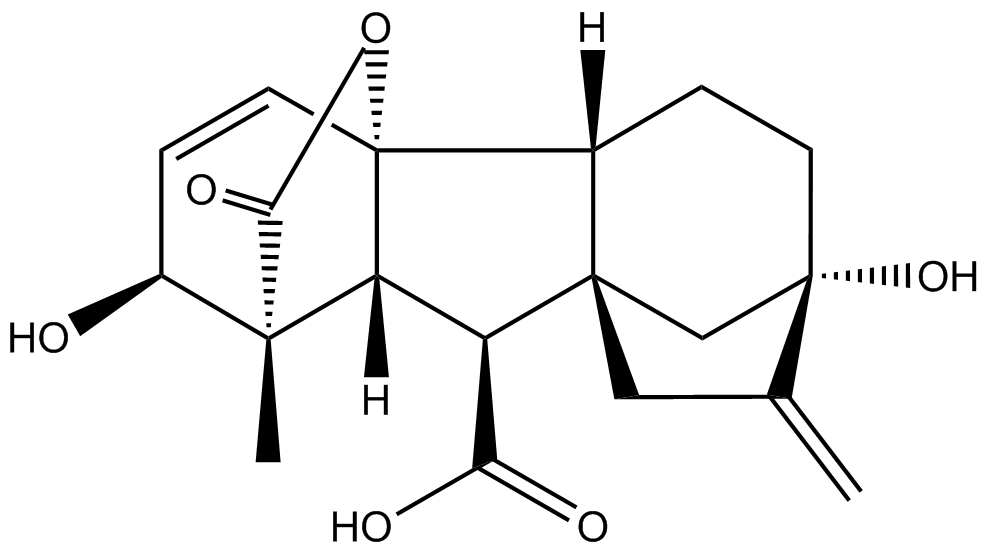
Gibberellic Acid
| ||||||||||||||||||||||||||||||||||||||||||||||||||||
| Solubility | KOH, EtOH |
| Physical Form | Solid |
| Solutions Available | G362 |
| Storage Temp. | 2 to 6 °C |
| Other Notes | Plant Tissue Culture Tested |
| UPC / SKU | G500 |
| CAS NUMBER | 77-06-5 |
| Formula Weight | 346.37 |
| Formula | C19H22O6 |
| Synonyms | GA3; Gibberellin A3 |
| Storage Temp. | 2 to 6 °C |
| Tariff Code | 2932.20.5050 |
| Risk Info (R) | 36/37/38 |
| Safety Info (S) | 26-36 |
No information available
G500 Gibberellic Acid
| Synonyms: | GA3; Gibberellin A3 |
| CAS: | 77-06-5 |
| Formula: | C19H22O6 |
| Mol. Weight: | 346.41 |
| Properties | |
|---|---|
| Form: | Powder |
| Appearance: | White to Cream |
| Application: | Plant Growth Regulator, Seed Testing |
| Solubility: | Ethanol (EtOH), 1N KOH |
| Typical Working Concentration: | 0.01 – 5.0 mg/L, varies depending on application, should be determined by end user. |
| Storage Temp: | 2 to 6˚ C |
| Other Notes: | Plant Tissue Culture Tested; For Research Use Only |
Application Notes
Gibberellins are known to promote shoot (internode) elongation and break certain dormancies in seeds. They also can induce flowering in some plant species.2
According to the CFIA (Canadian Food Inspection Agency), gibberellic acid can be used in a concentration range from 0.02-0.10% to break seed dormancy. The CFIA (2011) recommends that if a concentration of 0.08% or higher is to be used, the gibberellic acid should be dissolved in a phosphate buffer consisting of the following per liter of water:
1.78 g of Na2HPO4•2H2O or 2.68 g of Na2HPO4•7H2O (Prod. # S745)
1.38 g of NaH2PO4•H2O (Prod # S515)
It has been reported that low concentrations of GAs (0.01-5.0 mg/L) have been shown to promote shoot development in tobacco callus, while higher concentrations (5.0 mg/L to 10 mg/L) inhibit shoot production. 4
PhytoTechnology Laboratories® also carries Gibberellic Acid Solution at 13 mg/mL (Prod. No. G362), Gibberellic Acid Solution at 1 mg/mL (Prod. No. G198), and Gibberellins A4+A7 (Prod. No. G358).
Please Note: Gibberellins can be co-autoclaved with media components; however, some loss of activity may occur. While PhytoTechnology Laboratories™ tests each lot of this product with two or more plant cell/ tissue culture lines, it is the sole responsibility of the purchaser to determine the appropriateness of this product for the specific plants that are being cultured and applications that are being used
References
1. Merck 13, 4430
2. Harada H. and J. P. Nitsch (1959) Flower Induction in Japanese Chrysanthemums with Gibberellic Acid. Science , New Series 129;335, pp. 777-778.
3. Canadian Food Inspection Agency (2011) Canadian Methods and Procedures for Testing Seed. www.aosaseed.com/docs/Canadian_M&P_2011.pdf
4. Murashige, T (1961) Suppression of Shoot Formation in Cultured Tobacco Cells by Gibberellic Acid. Science, New Series, 134:3474, pp. 280.



